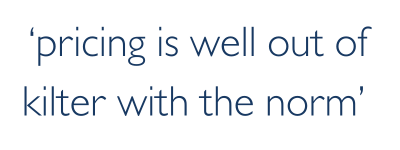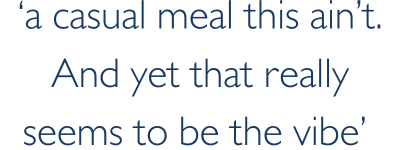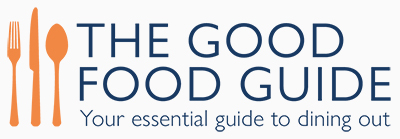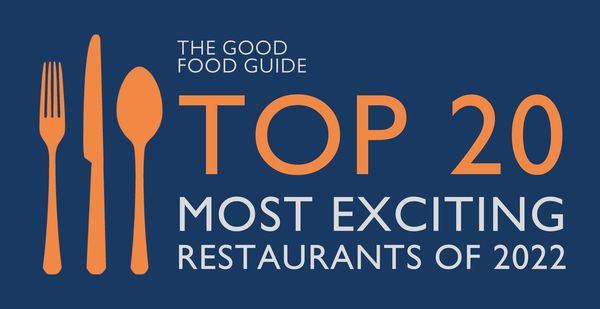A £200 turbot in a palatial room is harder to recommend than a £50 turbot in a shack because fewer people will be able, or willing, to pay for the palatial room. My idea for recommendablity stems from something other restaurant guides are seemingly oblivious to, but as a measure for scoring or rating a restaurant, how much it costs is now hugely relevant and needs a little bit of window-dressing so as not to feel distasteful.
I’ve always based my rating recommendations on those I make day to day among my friendship group. Here price is always a factor. But are my friends existing or target Good Food Guide subscribers? I don’t know. Perhaps the average Guide subscriber eats out twice weekly and spends £1000; or maybe it’s monthly with a £50 bill. More likely they are a varied bunch, but the point remains, I’d like to know more about the budgets, habits and preferences of both existing and target Guide subscribers so my rating/score recommendations can be geared towards them.
Why did Lita get me thinking about Good Food Guide subscribers? Because the prices are eye-watering to me. Even in London, where more and more meals are no longer what I would realistically call good value, Lita’s pricing is not only well out of kilter with the norm but also doesn’t reflect the products being used. Norfolk quail is not premium quail, so to see it here (albeit very nicely roasted and carved) as a £28 small plate with nothing but a very intense demiglace, a greengage purée, two halved duck hearts, some vast celery leaves (that I’m fairly certain were lovage), and a few slices of greengage is, well, a bit shocking, really. While more akin to a generous starter, I guess the plate could just about get away with being a main course, but if you want the sides that make it one, a seasonal leaf salad is £8, Pink Fir potatoes are £9, and a Nutbourne tomato salad is £12.

‘Limousin veal sweetbread, pomme purée, sweetcorn, girolles, Tropea onion’ for all its £32, at least sounds like a complete dish, although it absolutely wasn’t large enough to share or even constructed to share, while ‘chopped Hereford beef, Amalfi lemon, shoestring fries’ was barely a starter at an eyepopping £23. The veal sweetbread was flawless - superbly cooked – but the beef in the tartare was flavourless, just tasted of lemon zest and salt. The shoestring fries were superb, too, but needed a dip or sauce.
The meal began with the good old ‘have you visited us before, can I explain our menu’ script, which, as is typical in these situations, didn’t really lead to the menu or the ‘concept’ becoming any clearer. There are cold plates, hot plates and big plates. I wasn’t sure how many I should order or what the intended format of the meal was. Courses? All come at once? The big plates seemed immensely ambitious in their pricing. An 800g ‘Yorkshire pork chop and fillet, Scottish girolles, mustard fruit, peach’ was fairly emblematic at £84. I saw a few of these leave the kitchen, and you’d absolutely need sides for it to feed two as a shared main course.
Wine follows suit. The starting point appeared to be £54 for a fairly ordinary Picpoul, with some 20 by-the-glass options starting at £9 for a 125ml pour. The main supplier appears to be Les Caves and there is a definite natural slant to the list, although it doesn’t completely ignore the classics. Mark-ups are very, very high and the list shows no creative or smart buying to deliver value. Laurent Tribut Chablis, I’m assuming straight from Flint who have the agency, is a demented £120. I did, however, spot a mistake that meant one real bargain. The price of Lopez de Heredia’s very famous and hard to find Rosado 2012 was mixed up with the winemaker’s husband’s very similar wine, Ripa. £120 is below what you’ll pay retail in some places for a Vina Tondonia Rose.
Regardless, a casual meal out, this ain’t. And yet that really seems to be the vibe. It’s buzzy, fast-paced and with exposed beams, flagstone and scuffed parquet floors and appliances built into distressed brick walls, feels like a luxe Italian farmhouse more than a formal restaurant. The gleaming, varnished food counters, plush stools, shapely chandeliers, top-end kitchen appliances and seemingly endless number of staff give the game away, of course (this is a no expense spared project), but it doesn’t change the informal vibe. 
Staff sort of pull off the pricey/casual balance. The manager took an interest in me as a lone diner, although my actual server was a little stiff in their scripts and interactions. I think perhaps they need to review how rigidly staff are expected to interact and what information they need to deliver. And there were far, far too many chefs in the very open kitchen. Most of them had nothing to do – one could have run the service with half the number which perhaps helps explain the pricing.
What it doesn’t explain is how popular the place is. I’d say three quarters full when I arrived and it didn’t let up from 6.30-8pm. The cooking is GFG ‘Good’, certainly, but I wonder if this is a place more for the sort of well-heeled Marylebone locals who can comfortably afford it? I can’t help but think I’d just go to Bocca de Lupo, which would be less than half the price for generally far more enjoyable and sharable cooking. In fact, I could probably get in and out of Mountain for 25% less including far, far better wine, and that’s saying something. My suggestion, given the prohibitive pricing would be ‘Local Gem’, but the Guide’s gems actually have a focus on low pricing, so perhaps that doesn’t work either?
Is Lita a good restaurant? Yes. Is it a restaurant I would ever recommend? Absolutely not, unless to someone who could go as a guest or was living nearby and had pots of cash to spend.





